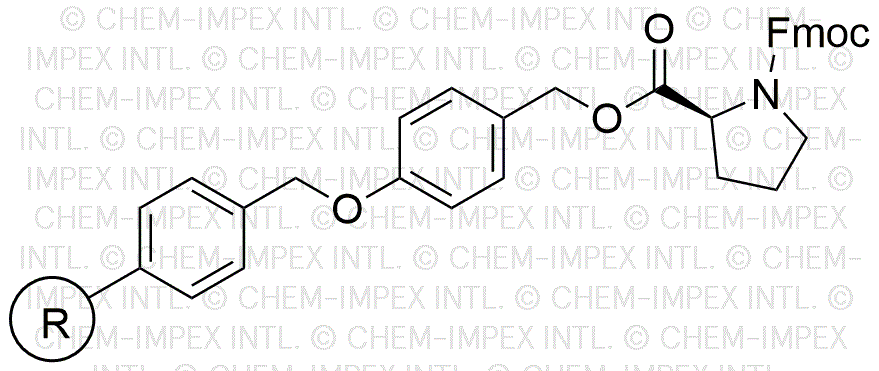Fmoc-L-proline 4-alkoxybenzyl alcohol is widely utilized in research focused on:
- Peptide Synthesis: This compound serves as a protecting group in the synthesis of peptides, allowing for the selective modification of amino acids without interfering with other functional groups.
- Drug Development: It plays a crucial role in the development of pharmaceutical compounds, particularly in creating prodrugs that enhance bioavailability and therapeutic efficacy.
- Bioconjugation: The compound is used in bioconjugation techniques, enabling the attachment of biomolecules to surfaces or other molecules, which is essential in diagnostics and therapeutic applications.
- Material Science: It finds applications in the creation of functionalized polymers and materials, contributing to advancements in drug delivery systems and smart materials.
- Research in Organic Chemistry: Researchers utilize it for studying reaction mechanisms and developing new synthetic methodologies, benefiting from its unique structural properties.
Información general
Propiedades
Seguridad y normativas
Aplicaciones
Fmoc-L-proline 4-alkoxybenzyl alcohol is widely utilized in research focused on:
- Peptide Synthesis: This compound serves as a protecting group in the synthesis of peptides, allowing for the selective modification of amino acids without interfering with other functional groups.
- Drug Development: It plays a crucial role in the development of pharmaceutical compounds, particularly in creating prodrugs that enhance bioavailability and therapeutic efficacy.
- Bioconjugation: The compound is used in bioconjugation techniques, enabling the attachment of biomolecules to surfaces or other molecules, which is essential in diagnostics and therapeutic applications.
- Material Science: It finds applications in the creation of functionalized polymers and materials, contributing to advancements in drug delivery systems and smart materials.
- Research in Organic Chemistry: Researchers utilize it for studying reaction mechanisms and developing new synthetic methodologies, benefiting from its unique structural properties.
Documentos
Hojas de datos de seguridad (HDS)
La SDS proporciona información de seguridad completa sobre la manipulación, el almacenamiento y la eliminación del producto.
Especificación del producto (PS)
La PS proporciona un desglose completo de las propiedades del producto, incluida la composición química, el estado físico, la pureza y los requisitos de almacenamiento. También detalla los rangos de calidad aceptables y las aplicaciones previstas del producto.
Certificados de análisis (COA)
Busque certificados de análisis (COA) ingresando el número de lote del producto. Los números de lote y de partida se pueden encontrar en la etiqueta de un producto después de las palabras "Lote" o "Lote".
Número de catálogo
Número de lote/lote
Certificados de origen (COO)
Este certificado de origen confirma el país en el que se fabricó el producto y también detalla los materiales y componentes utilizados en él y si se deriva de fuentes naturales, sintéticas u otras fuentes específicas. Este certificado puede ser necesario para cumplir con las normativas aduaneras, comerciales y regulatorias.
Número de catálogo
Número de lote/lote
Hojas de datos de seguridad (HDS)
La SDS proporciona información de seguridad completa sobre la manipulación, el almacenamiento y la eliminación del producto.
DownloadEspecificación del producto (PS)
La PS proporciona un desglose completo de las propiedades del producto, incluida la composición química, el estado físico, la pureza y los requisitos de almacenamiento. También detalla los rangos de calidad aceptables y las aplicaciones previstas del producto.
DownloadCertificados de análisis (COA)
Busque certificados de análisis (COA) ingresando el número de lote del producto. Los números de lote y de partida se pueden encontrar en la etiqueta de un producto después de las palabras "Lote" o "Lote".
Número de catálogo
Número de lote/lote
Certificados de origen (COO)
Este certificado de origen confirma el país en el que se fabricó el producto y también detalla los materiales y componentes utilizados en él y si se deriva de fuentes naturales, sintéticas u otras fuentes específicas. Este certificado puede ser necesario para cumplir con las normativas aduaneras, comerciales y regulatorias.

